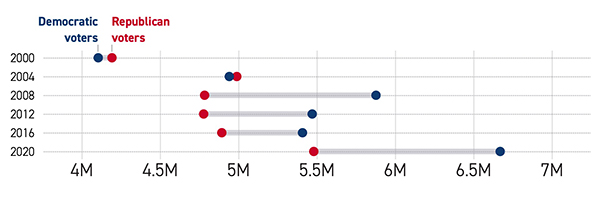

No, not the Electoral College. That is still working fine for them. It is regular colleges that are the problem. Consider Wisconsin, for example. Normally, the two big Democratic counties, Milwaukee and Dane (Madison), are balanced by the rural rest of the state. In April there was a race for state Supreme Court justice. Normally, April elections are low-turnout affairs. Something happened this year. Turnout in Dane, which holds the University of Wisconsin's main campus and the state capital, was higher than in any other county and also more lopsided for the Democrats. It was so big that it changed the state's math by overwhelming the Milwaukee suburbs, which are trending left anyway. If the turnout in Dane becomes the new normal, it will have a big impact on who gets Wisconsin's 10 electoral votes and all statewide races going forward.
Wisconsin is not alone. In 2000, Al Gore won Washtenaw County (Ann Arbor and the University of Michigan) by 24 points (60% to 36%) and 34,000 votes. In 2020, Joe Biden won it by almost 50 points (72% to 23%) and 101,000 votes. In college towns in Arizona, Colorado, Georgia, Iowa, Kansas, Kentucky, Ohio, Texas, and Virginia, the same dynamic is playing out. Their counties were often reliably Democratic in the past, but they are producing landslides now and in some cases big enough landslides to overwhelm rural counties elsewhere in the state. Not all, but the trend is the wrong way for Republicans.
The effect extends even to smaller municipalities. The American Communities Project has produced a list of 171 small-to-medium college towns. Since 2000, 38 have flipped from red to blue and only seven have flipped from blue to red, and usually by smaller margins. Counties that went blue did so by an average of 16,253 votes, whereas counties that went red did so by an average of 4,063 votes. Also, two-thirds of the counties with college towns have grown more Democratic since 2000.
The ACP list of college towns doesn't include many large universities because they are in large cities and counties. But the effect is similar. Travis County, TX (Austin, where the University of Texas' main campus is), became 290,000 votes bluer in 2020 than in 2000. Hennepin County, MN (Minneapolis, where the University of Minnesota is), became 245,000 votes bluer in the same timeframe. Bernalillo County, NM (Albuquerque, where the University of New Mexico is), became 73,000 votes bluer.
North Carolina is a state that will be in the spotlight in 2024 (see above). There are nine counties there with college towns. Five of the nine have gone blue since 2000. Together the nine netted 12,000 votes for George W. Bush, who carried the state by 13 points. In 2020, Joe Biden netted 222,000 votes in those nine counties and Donald Trump carried the state by 1 point. For the Republicans, this is not a great trend.
College towns are becoming so important due to several factors. Some of the campuses have expanded, bringing in more left-leaning students and faculty members. Start-ups spawned by university research are also bringing in more people who lean Democratic. The quality of life there, from the arts scene to local craft beers, also tends to pull in more Democrats than Republicans.
The chart below shows the combined votes of the counties where the 171 college towns are located:

This result is not entirely surprising, since both young voters and college-educated voters are swinging toward the Democrats. Naturally, the intersection of the two will swing even harder. This suggests that the Democrats should set up shop at the Universities of Arizona, Wisconsin, Georgia, and North Carolina, and make a big effort to engage students and faculty members. The potential payoff could be large.
Republicans could at least stop being so negative about higher education. Donald Trump recently wrote that he would "fire the radical left accreditors and hire new ones who will impose real standards on colleges." Those standards would include "removing all Marxist diversity, equity, and inclusion bureaucrats." Last month, Ron DeSantis sued the Biden administration over accrediting procedures. Students who receive federal aid must attend an accredited college or university. Among Republicans, only 19% have faith in higher education.
Traditionally, Republicans have viewed higher education as job training, so the metric for doing a good job is how much money graduates make. Democrats have tended to regard it as a place where students learn to think for themselves and criticize things they see as wrong. These views are not really compatible, and it is clear why college towns are hotbeds of anti-Republican politics and why the Republicans are unhappy about that. (V)